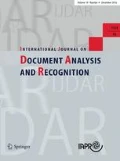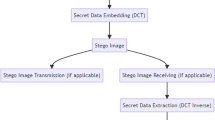Abstract
Motivated by increasing possibility of the tampering of genuine documents during a transmission over digital channels, we focus on developing a watermarking framework for determining whether a received document is genuine or falsified, which is performed by hiding a security feature or secret information within it. To begin with, the input document is transformed into a standard form to minimize geometric distortion. Fully convolutional network (FCN) is utilized to detect document’s watermarking regions. Next, we construct hiding patterns used for hiding secret information. Modifying pixel values of these patterns for carrying secret bits depends on the edge and corner features of document content and the connectivity of their neighboring pixels. Lastly, the watermarking process is conducted by either changing the center pixel of the hiding patterns or changing the ratio between the number of edge features and the number of corner features of subregions within the watermarking regions. The experiments are performed on various binary documents, and our approach gives competitive performance compared to state-of-the-art approaches.



















Similar content being viewed by others
References
Apostolos, A., Bridson, D., Papadopoulos, C., Pletschacher, S.: A realistic dataset for performance evaluation of document layout analysis. ICDAR ’09 (2009)
Benoraira, A., Benmahammed, K., Boucenna, N.: Blind image watermarking technique based on differential embedding in DWT and DCT domains. EURASIP 2015(1), 55 (2015)
Bay, H., Ess, A., Tuytelaars, T., Van Gool, L.: Speeded-up robust features (surf). Comput. Vis. Image Underst., (2008)
Cao, H., Kot, A.C.: On establishing edge adaptive grid for bilevel image data hiding. IEEE Trans. Inf. Forensics Secur. 8(9), 1508–1518 (2013)
Cheng, J., Kot, A.C.: Objective distortion measure for binary text image based on edge line segment similarity. IEEE Trans. Image Process. 16(6), 1691–1695 (2007)
Chetan, K., Nirmala, S.: An efficient and secure robust watermarking scheme for document images using integer wavelets and block coding of binary watermarks. Trans. Inf. Security Appl. 24, 13–24 (2015)
Cu, V.L., Burie, J.C., Ogier, J.M.: Document images watermarking for security issue using fully convolutional networks. In: International Conference on Pattern Recognition (2018)
Cu, V.L., Burie, J.C., Ogier, J.M.: Stable regions and object fill-based approach for document images watermarking. In: 13th IAPR International Workshop on Document Analysis Systems (2018)
Cunha, A.L.D., Zhou, J., Do, M.N.: The nonsubsampled contourlet transform: Theory, design, and applications. IEEE Trans. Image Process. 15(10), 3089–3101 (2006)
Daraee, F., Mozaffari, S.: Watermarking in binary document images using fractal codes. Pattern Recogn. Lett. 35(2014), 120–129 (2014)
Hamid, A.S., Mansour, J.: Robust watermarking against print and scan attack through efficient modeling algorithm. Image Commun. 29(10), 1181–1196 (2014)
Haribabu, K., Subrahmanyam, G.R.K.S., Mishra, D.: A robust digital image watermarking technique using auto encoder based convolutional neural networks. In: WCI (2015)
Hieu, V., Dang, W., Kinsner, Y.W.: Multiobjective image data hiding based on neural networks and memetic optimization. WSEAS Trans. Signal Process. 10, 645–661 (2014)
Hou, Q., Junping, D., Li, L., Lu, J., Chang, C.C.: Scanned binary image watermarking based on additive model and sampling. Multimedia Tools Appl. 74(21), 9407–9426 (2015)
Hu, S.: Document image watermarking based on weight-invariant partition using support vector machine. In: DAS VI (2004)
Jamali, M., Rafiee, S., Soroushmehr, S.M.R., Karimi, N., Shirani, S., Najarian, K., Samavi, S.: Adaptive blind image watermarking using fuzzy inference system based on human visual perception. CoRR (2017)
Jinn, H.S., Didi, R., Pingzhi, F., Xian, W., Khurram, K.M.: An adaptive watermarking scheme for e-government document images. Multimedia Tools Appl. 72(3), 3085–3103 (2014)
Jung, K.H., Kee-Young, Y.: Data hiding method in binary images based on block masking for key authentication. Inf. Sci. 277, 188–196 (2014)
Kim, Y.W., Moon, K., Oh, I.S.: A text watermarking algorithm based on word classification and inter-word space statistics. In: ICDAR ’03 (2003)
Kim, Y.W., Seok, O.: Watermarking text document images using edge direction histograms. Pattern Recogn. Lett. 25(11), 1243–1251 (2004)
Lee, Y., Kim, H., Park, Y.: A new data hiding scheme for binary image authentication with small image distortion. Inf. Sci. 179(22), 3866–3884 (2009)
Li, L., Hou, Q., Lu, J., Xu, Q., Dai, J., Mao, X., Chang, C.C.: A new pixels flipping method for huge watermarking capacity of the invoice font image. Sci. World J. 2014, 895063 (2014). https://doi.org/10.1155/2014/895063
Lu, H., Shi, X., Shi, Y.Q., Kot, A.C., Chen, L.: Watermark embedding in DC components of DCT for binary images. In: MMSP (2002)
Munib, S., Khan, A.: Robust image watermarking technique using triangular regions and zernike moments for quantization based embedding. Multimed. Tools Appl. 76(6), 8695–8710 (2017)
Matas, J., Chum, O., Urban, M., Pajdla, T.: Robust wide baseline stereo from maximally stable extremal regions. Image Vision Comput. 22(10), 761–767 (2002)
Mun, S.M., Nam, S.H., Jang, H.U., K., D., Lee, H.K.: A robust blind watermarking using convolutional neural network. CoRR (2017)
Nguyen, T.S., Chang, C.C., Hsueh, H.S.: High capacity data hiding for binary image based on block classification. Multimed. Tools Appl. 75(14), 8513–8526 (2016)
Palit, S., Garain, U.: A novel technique for the watermarking of symbolically compressed documents. In: DIAL’06, vol. 2006 (2006)
Shelhamer, E., Long, J., Darrell, T.: Fully convolutional networks for semantic segmentation. IEEE Trans. Pattern Anal. Mach. Intell. 39(4), 640–651 (2017)
Shih, F.Y.: Digital Watermarking and Steganography: Fundamentals and Techniques, 2 edn (2017)
Simonyan, K., Zisserman, A.: Very deep convolutional networks for large-scale image recognition. CoRR (2014)
Tan, L., Sun, X., Sun, G.: Print-scan resilient text image watermarking based on stroke direction modulation for chinese document authentication. Radioengineering (2012)
Varna, A.L., Rane, S., Vetro, A.: Data hiding in hard-copy text documents robust to print, scan and photocopy operations. In: International Conference on Acoustics, Speech and Signal Processing (2009)
Wang, C., Chang, Y., Chang, C., Jan, J., Lin, C.: A high capacity data hiding scheme for binary images based on block patterns. J. Syst. Softw. 93(2014), 152–162 (2014)
Xiao, C., Zhang, C., Zheng, C.: Fontcode: embedding information in text documents using glyph perturbation. ACM Trans. Graph 37(2), 1–16 (2018)
Yang, H., Kot, A.C.: Pattern-based data hiding for binary image authentication by connectivity-preserving. IEEE Trans. Multimed. 9(3), 475–486 (2007)
Wang, Z., Bovik, A.C., Sheikh, H.R., Simoncelli, E.P.: Image quality assessment: from error visibility to structural similarity. IEEE Trans. Image Process. 13(4), 600–612 (2004)
Zeng, X.T., Ping, L.D., Pan, X.Z.: A lossless robust data hiding scheme. Pattern Recogn. 43(4), 1656–1667 (2010)
Zolotavkin, Y., Juhola, M.: A new two-dimensional quantization method for digital image watermarking. In: ICACT (2015)
Zou, D., Shi, Y.Q.: Formatted text document data hiding robust to printing, copying and scanning. In: ISCAS (2005)
Acknowledgements
This work is supported by the CPER NUMERIC programme funded by the Region Nouvelle Aquit-aine, CDA, Charente Maritime French Department, La Roche-lle conurbation authority (CDA) and the European Union through the FEDER funding.
Author information
Authors and Affiliations
Corresponding author
Additional information
Publisher's Note
Springer Nature remains neutral with regard to jurisdictional claims in published maps and institutional affiliations.
Rights and permissions
About this article
Cite this article
Cu, V.L., Nguyen, T., Burie, JC. et al. A robust watermarking approach for security issue of binary documents using fully convolutional networks. IJDAR 23, 219–239 (2020). https://doi.org/10.1007/s10032-020-00355-z
Received:
Revised:
Accepted:
Published:
Issue Date:
DOI: https://doi.org/10.1007/s10032-020-00355-z




